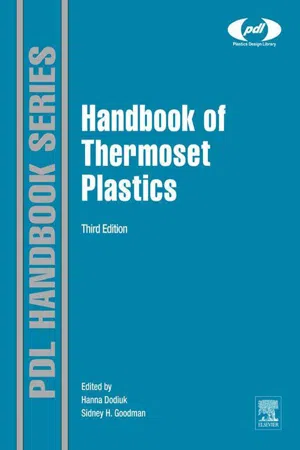Chemistry
Epoxide
Epoxide is a cyclic ether with a three-membered ring containing an oxygen atom and two carbon atoms. It is a highly reactive compound and is commonly used in organic synthesis as a building block for more complex molecules. Epoxides are also used as cross-linking agents in polymer chemistry.
Written by Perlego with AI-assistance
Related key terms
Related key terms
1 of 4
Related key terms
1 of 3
4 Key excerpts on "Epoxide"
- eBook - ePub
- Ning Jiao, Shannon S. Stahl, Ning Jiao, Shannon S. Stahl(Authors)
- 2019(Publication Date)
- Wiley(Publisher)
4 Green Oxidative Synthesis of EpoxidesMiquel CostasFacultat de Ciències, Departament de Química I Institut de Química Computacional i Catàlisi, Universitat de Girona, Girona, Spain4.1 Introduction
Epoxides are strained three‐membered heterocycles that have a high interest in organic synthesis because they exhibit a very versatile reactivity (Scheme 4.1 ). Most remarkably, they can be ring‐opened by a number of nucleophiles with high control over regio‐ and stereochemistry [1 ]. This aspect makes Epoxides convenient starting points for the preparation of a number of 1,2‐difunctionalized products.Representative examples of the reactivity of Epoxides.Scheme 4.1Epoxides are most commonly prepared by three different methods (Scheme 4.2 ).General methods for preparation of Epoxides.Scheme 4.2The most common method is the direct epoxidation of olefins, by reaction with an oxidant, most commonly a peroxide or peracid (Scheme 4.2 a), but also via a metal‐catalyzed oxidation reaction with a number of oxidants [2 –4 ]. Epoxides can be also prepared by ring closing of halohydrins on reaction with a base (Scheme 4.2 b). Halohydrins are initially formed by reaction of an olefin and hypochlorous acid. Alternatively, the hypochlorous acid can be prepared in situ by reaction of Cl2 and water. This method is used in the large‐scale production of propene oxide and in the production of epichlorohydrin [5 –7 ]. Finally, Epoxides can be also synthetized by reaction of aldehydes or ketones with ylides (Scheme 4.2 c) [8 ].Epoxidation of olefins is a well‐established and particularly useful reaction because olefins are largely available starting materials. However, the vast majority of current methods are far from satisfactory from a number of perspectives. In the first place, some epoxidizing agents exhibit poor atom economy in their reactions, and delivery of the oxygen atom occurs at the expense of the production of a large number of byproducts. In addition, because of the rich reactivity of Epoxides, chemoselectivity remains a critical aspect in epoxidations with aggressive oxidants and acidic conditions. Paradigmatically, the epoxidation performed with peracids, known as the Prilezhaev reaction, is widely employed in organic synthesis [9 ]. For example, epoxidations with electron poor peracids, such asm‐chloro perbenzoic acid(MCPBA ), are reliable reactions, with a wide substrate scope. However, they produce the corresponding carboxylic acid as a by‐product. Peracetic acid is also employed in large‐scale epoxidations [2 - eBook - ePub
Organic Chemistry Study Guide
Key Concepts, Problems, and Solutions
- Robert J. Ouellette, J. David Rawn(Authors)
- 2014(Publication Date)
- Elsevier(Publisher)
16Ethers and Epoxides
Keys to the Chapter
The chemistry of ethers has substantially less variety than the chemistry of alcohols because several of the reactions of alcohols involve the O—H bond, namely dehydration and oxidation reactions are not possible for ethers. However, if comparable reactions are considered, such as substitution, then alcohols and ethers have similar reactivities. The reactions of Epoxides are the result of ring strain, which leads to the formation of ring-opened products.16.1 Structure of Ethers
Ethers contain an oxygen atom bonded to two alkyl groups, two aryl groups, or one of each. The geometry of ethers resembles that of alkanes, with the substitution of a methylene carbon atom by an sp2 -hybridized oxygen atom. Conformations of ethers resemble those of alkanes. The two nonbonding electron pairs of the ether oxygen are directed to the corners of a tetrahedron.16.2 Nomenclature of Ethers
The common names of simple ethers are based on the names of the alkyl or aryl groups bonded to the oxygen atom. The name results from listing the alkyl (or aryl) groups in alphabetical order and appending the name ether.The IUPAC name is based on the longest carbon chain bonded to the oxygen atom. The smaller group bonded to the oxygen atom is named as an alkoxy group and is regarded as a substituent on the longer chain.The three-, five-, and six-membered cyclic ethers have common names. Three-membered ring compounds are called Epoxides of the corresponding alkene from which they may be synthesized. The common names of five- and six-membered ring compounds are called tetrahydrofurans and tetrahydropyrans, respectively. In the IUPAC system, each ring size has a specific name. The names for cyclic ethers having three-, four-, five-, and six-membered rings are oxirane, oxetane, oxolane, and oxane, respectively. The oxygen atom in each ring is assigned the number 1, and the ring is numbered in the direction that gives the lowest numbers to substituents. - eBook - ePub
- Edwin Vedejs, Scott E. Denmark, Edwin Vedejs, Scott E. Denmark(Authors)
- 2016(Publication Date)
- Wiley-VCH(Publisher)
23Reactions of Epoxides (n → σ* )Tyler W. Wilson1 and Scott E. Denmark21 Gilead Sciences, Process Chemistry, 333 Lakeside Drive, Foster City, CA 94404, USA 2 University of Illinois, Department of Chemistry, 245 Roger Adams Laboratory, 600 South Mathews Avenue, Urbana, IL 61801, USA23.1 Introduction
The availability and versatility of Epoxides elevates them as a highly valued functional group in synthetic organic chemistry [1]. Epoxides are readily prepared by the direct oxidation of olefins and tremendous success has been achieved for both diastereoselective [2] and enantioselective preparations of oxiranes [3]. In parallel with advances for their synthesis, strategies for the site- and stereoselective opening of Epoxides have been developed that harness their strain energy for myriad transformations [4]. For example, the ring opening of Epoxides with nucleophiles, which can proceed with clean inversion of configuration by an SN 2 pathway, allows the construction of vicinal stereogenic centers with high stereochemical fidelity. Taken together, these processes of epoxidation and nucleophilic ring opening provide an extremely powerful method for transforming simple olefins into diverse arrays of chiral 1,2-difunctionalized building blocks.23.1.1 Lewis Acid-Catalyzed, Enantioselective Epoxide Opening
The ability of chiral Lewis acids to catalyze the desymmetrization of meso-Epoxides is now well established. Unlike most enantioselective transformations that involve enantiotopic face selection with compounds that contain no stereogenic centers, these reactions involve enantiotopic group selection with Cs -symmetric compounds containing two or more stereogenic centers. The power of this type of transformations is that a number of stereogenic centers can be unveiled in a single step (Eq. (23.1) ) [5]. The scope of the nucleophile for this process has evolved beginning with early studies by Nugent, who identified silyl azides as particularly effective nitrogen-based nucleophiles for Epoxide opening using a zirconium alkoxide complex as the catalyst [6]. Later, Jacobsen greatly extended the field of meso-Epoxide opening by employing chiral Cr- and Co-salen complexes for the reactions of Epoxides with silyl azides, alcohols, and carboxylic acids [5a]. More recently, the scope of this process has been expanded to include phenols and sulfur-based nucleophiles by Shibasaki and coworkers, who described the use of a gallium–lithium BINOL complex as the catalyst [7]. These along with many other contributions have now made the Lewis acid-catalyzed opening of meso - eBook - ePub
- Hanna Dodiuk(Author)
- 2013(Publication Date)
- William Andrew(Publisher)
Also in the early 1940s, Daniel Swern developed an alternate route to epoxy formation by formulating resins through the reaction of peroxy acids with olefins. This development is in close resemblance to the current commercial processes used in the creation of epoxy compounds as plasticizer-stabilizers.In the decades that followed, a proliferation of new epoxies was realized and within the span of 20 years there were at least 25 different epoxies in existence. Industrial usage of epoxies also became widespread with the first commercial production beginning in 1947. Since that time, the market for epoxy resins has continued its growth due to additional applications. Projections show an estimated growth of about 3–4% annually with a 2015 market estimated at $21 billion [3] .Basic Chemistry and Some General Remarks
The generic term epoxy (Epoxide in Europe) is now understood to mean the base (thermoplastic, uncured) resins as well as the resultant cross-linked (thermoset, cured) plastic. Chemically, an epoxy resin contains more than one α-epoxy group situated terminally, cyclically, or internally in a molecule; it can be converted to a solid through a thermosetting reaction.The α-epoxy (or 1,2-epoxy) is the most common type of functional moiety. Ethylene oxide (Structure 8.1 ) is the simplest type of 1,2-epoxy. This ring is also referred to as the oxirane ring. Another common group in this resin class is the glycidyl group (Structure 8.2 ).Structure 8.1 Ethylene oxide.Structure 8.2 Glycidyl group.The demands of the structural composites field spurred development of high-performance epoxies. These requirements were met by increasing the functionality (number of Epoxide groups per molecule), modifying curing agents, and replacing the thermally weak aliphatic linkages in glycidyl groups with rigid bonds.The ring-opening polymerization and cross-linking in epoxy resins can be of two general types, catalyzed homopolymerization or bridging reactions incorporating a co-reactive cross-linking agent into the network. Homopolymerization, or reactions between epoxy chains, involves elimination reactions on the oxygen atom of the Epoxide group using acid or base catalysts, often activated by radiation. The incorporation, or bridging reaction, involves nucleophilic attack on one of the Epoxide carbons by an amine or an anhydride compound (see the next sections for more details). Reviews of curing reactions are available in the literature, and terminology has been standardized by the International Union of Pure and Applied Chemistry (IUPAC). An obvious and important difference in the result of the two different curing methods is that in homopolymerization the network is only composed of the cross-linked epoxy monomers, whereas in the bridging reaction the network is composed of a copolymer of both epoxy monomers and a curing agent. Therefore, in a bridging reaction the network properties are a function of two components, which allows modifications to be incorporated in either component. Thus, a rigid epoxy with high strength can be used with an impact-resistant hardener to yield a desirable network.
Index pages curate the most relevant extracts from our library of academic textbooks. They’ve been created using an in-house natural language model (NLM), each adding context and meaning to key research topics.
Explore more topic indexes
Explore more topic indexes
1 of 6
Explore more topic indexes
1 of 4



